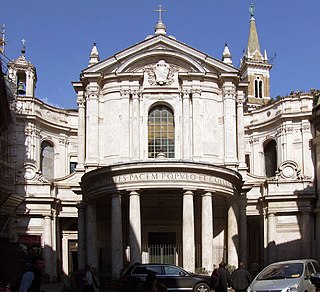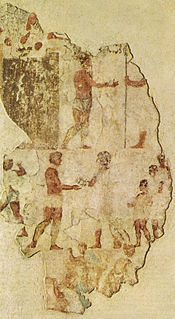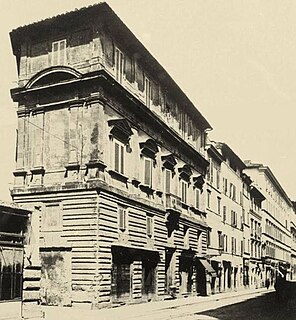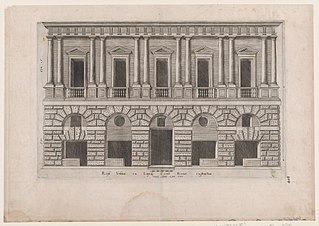
Baldassare Tommaso Peruzzi was an Italian architect and painter, born in a small town near Siena and died in Rome. He worked for many years with Bramante, Raphael, and later Sangallo during the erection of the new St. Peter's. He returned to his native Siena after the Sack of Rome (1527) where he was employed as architect to the Republic. For the Sienese he built new fortifications for the city and designed a remarkable dam on the Bruna River near Giuncarico. He seems to have moved back to Rome permanently by 1535. He died there the following year and was buried in the Rotunda of the Pantheon, near Raphael.

The Villa Farnesina is a Renaissance suburban villa in the Via della Lungara, in the district of Trastevere in Rome, central Italy.

The Basilica of St. Augustine in Campo Marzio, commonly known as Basilica of St. Augustine and locally as Sant'Agostino, is a Roman Catholic titular minor basilica dedicated to Saint Augustine in Rome, Italy. It is the mother church of the Order of Saint Augustine and it is located near the Piazza Navona in the rioneSant'Eustachio.

Santa Maria dei Miracoli and Santa Maria di Montesanto are two churches in Rome.

The Temple of Antoninus and Faustina is an ancient Roman temple in Rome, which was later converted into a Roman Catholic church, the Chiesa di San Lorenzo in Miranda or simply "San Lorenzo in Miranda". It is located in the Forum Romanum, on the Via Sacra, opposite the Regia.

Santa Maria della Pace is a church in Rome, central Italy, not far from Piazza Navona. The building lies in rione Ponte.

Santa Maria in Via Lata is a church on the Via del Corso, in Rome, Italy. It stands diagonal from the church of San Marcello al Corso.

Sant'Onofrio al Gianicolo is a titular church in Trastevere, Rome. It is the official church of the papal order of knighthood Order of the Holy Sepulchre. A side chapel is dedicated to the Order and a former grand master, Nicola Canali is entombed there. It is dedicated to Saint Onuphrius and located on the Janiculum.

Palazzo Torlonia is a 16th-century Renaissance town house in Via della Conciliazione, Rome, Italy. Built for Cardinal Adriano Castellesi da Corneto from 1496, the architect was Andrea Bregno, although others have attributed the design to Bramante.

The Esquiline Necropolis was a prehistoric necropolis on the Esquiline in Rome, in use until the end of the 1st century AD.

The Basilica of Junius Bassus was a civil basilica on the Esquiline Hill in Rome, on a site now occupied by the Seminario Pontificio di Studi Orientali, in via Napoleone III, 3. It is best known for its examples of opus sectile work.

Palazzo Aragona Gonzaga is a 16th-century palace in Rome, Italy; it was once the residence of Cardinal Scipione Gonzaga. Today, its late Renaissance street facade bears plaques commemorating two of its residents, Saint Aloysius Gonzaga and the poet Torquato Tasso.

Palazzo Jacopo da Brescia was a Renaissance palace in Rome, Italy, which was located in the Borgo rione.

Palazzo Caprini was a Renaissance palazzo in Rome, Italy, in the Borgo rione between Piazza Scossacavalli and via Alessandrina. It was designed by Donato Bramante around 1510, or a few years before.

Santi Celso e Giuliano is a minor basilica church in Rome, Italy. It has held this status by custom and practice since ancient times. The church is located on Vicolo del Curato number 12, just off Via del Banco di Santo Spirito, the road leading to Ponte Sant'Angelo.

Santa Caterina da Siena is a church in Rome dedicated to Catherine of Siena. It is sited on via Giulia in the Regola district.

Via dei Coronari is a street in the historic center of Rome. The road, flanked by buildings mostly erected in the 15th and the 16th century, belongs entirely to the rione Ponte and is one of the most picturesque roads of the old city, having maintained the character of an Italian Renaissance street.

Palazzo dei Convertendi is a reconstructed Renaissance palace in Rome. It originally faced the Piazza Scossacavalli, but was demolished and rebuilt along the north side of Via della Conciliazione, the wide avenue constructed between 1936 and 1950, which links St Peter's Basilica and the Vatican City to the centre of Rome. The palace is famous as the last home of the painter Raphael, who died there in 1520.

The Fontana della Navicella is a fountain built around a marble and travertine replica of an Ancient Roman sculpture, depicting a decorated Roman Galley, and erected in front of the church of Santa Maria in Domnica of Rome, Italy. While the statue is a copy (1518-1519) made by Andrea Sansovino on commission from Pope Leo X based on fragments discovered near the church.

Piazza Scossacavalli, also named Piazza di San Clemente, Piazza di Trento, Piazza d'Aragona, Piazza Salviati, was a square in Rome, Italy, important for historical and architectonic reasons. The square was demolished together with the surrounding quarter in 1937 due to the construction of Via della Conciliazione.





















